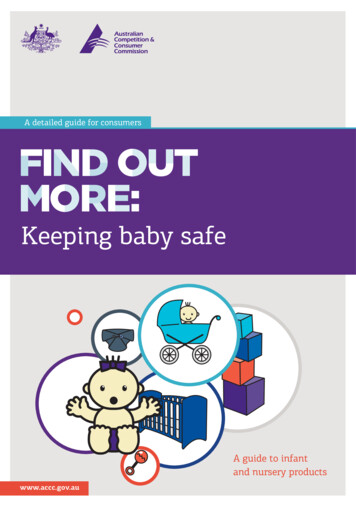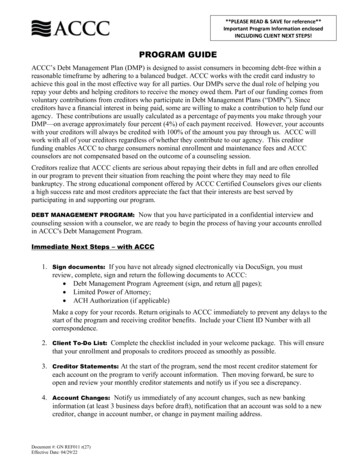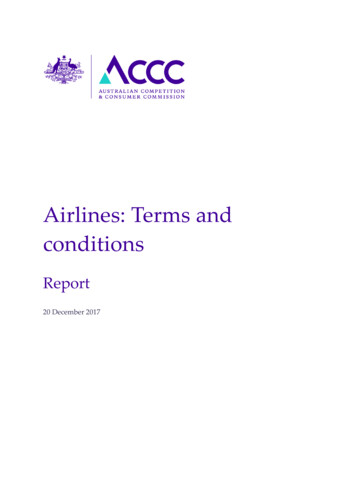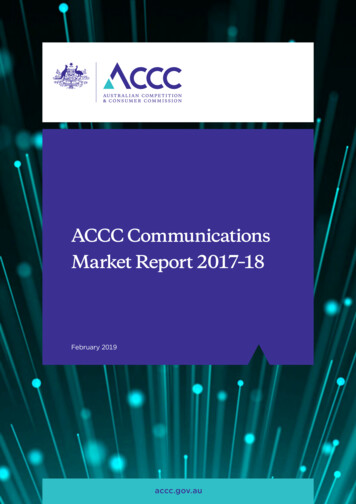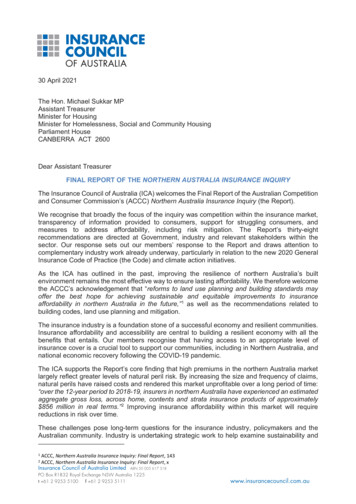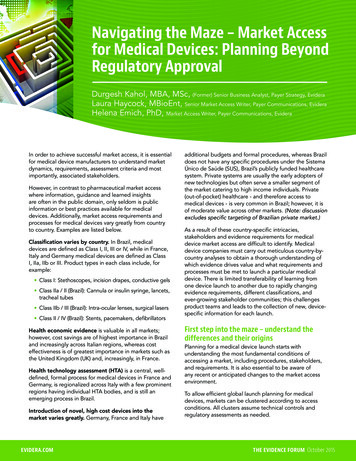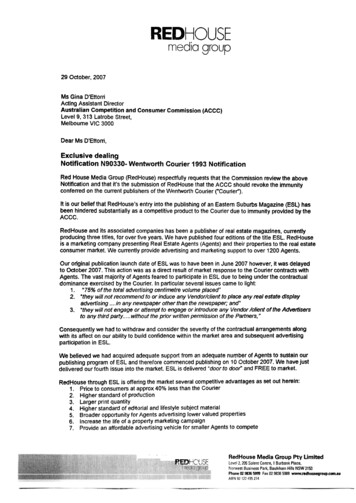
Transcription
ACCCCommunicationsMarket Report2018–19December 2019accc.gov.au
Australian Competition and Consumer Commission23 Marcus Clarke Street, Canberra, Australian Capital Territory, 2601 Commonwealth of Australia 2019This work is copyright. In addition to any use permitted under the Copyright Act 1968, all material contained within this work is providedunder a Creative Commons Attribution 3.0 Australia licence, with the exception of: the Commonwealth Coat of Arms the ACCC and AER logos any illustration, diagram, photograph or graphic over which the Australian Competition and Consumer Commission does not holdcopyright, but which may be part of or contained within this publication.The details of the relevant licence conditions are available on the Creative Commons website, as is the full legal code for the CC BY 3.0 AUlicence.Requests and inquiries concerning reproduction and rights should be addressed to the Director, Content and Digital Services, ACCC,GPO Box 3131, Canberra ACT 2601.Important noticeThe information in this publication is for general guidance only. It does not constitute legal or other professional advice, and should not berelied on as a statement of the law in any jurisdiction. Because it is intended only as a general guide, it may contain generalisations. Youshould obtain professional advice if you have any specific concern.The ACCC has made every reasonable effort to provide current and accurate information, but it does not make any guarantees regardingthe accuracy, currency or completeness of that information.Parties who wish to re-publish or otherwise use the information in this publication must check this information for currency and accuracyprior to publication. This should be done prior to each publication edition, as ACCC guidance and relevant transitional legislationfrequently change. Any queries parties have should be addressed to the Director, Content and Digital Services, ACCC, GPO Box 3131,Canberra ACT 2601.ACCC 12/19 1628www.accc.gov.au
ContentsGlossaryivTypes of Internet Access Platforms41.Executive Summary52.Competition indicators132.1Wholesale market indicators132.2Retail market indicators212.3Consumer trends and related issues423.4.5.ACCC activities in communications513.1Access to telecommunications513.2National Broadband Network523.3Structural separation of Telstra543.4NBN Migration Plan activities543.5Monitoring and reporting563.6Enforcement and compliance activities573.7Merger, authorisation and third line forcing reviews603.8Advice, advocacy and contributions to policy processes62Communications sector market study follow-ups644.164Internet interconnection4.2e-SIMs654.3Communications comparison tools66Appendices675.1Access to telecommunications services675.2NBN and non-NBN superfast services regulatory frameworks685.3Telstra’s structural separation and other Telecommunications Act provisions695.4Record keeping rules725.5Price monitoring methodology: calculating real changes in weightedaverage prices through a ‘plan matching’ approach73Price monitoring methodology: calculating real changes in weightedaverage prices through a ‘hedonic’ approach775.6ACCC Communications Market Report 2018–19iii
Glossary3G / 4G / 5G third/fourth/fifth generation mobile communicationsABS Australian Bureau of StatisticsACCC Australian Competition and Consumer CommissionACL Australian Consumer LawACMA Australian Communications and Media AuthorityADSL asymmetric digital subscriber lineAGVC aggregating virtual circuitBROC binding rule of conductCAN customer access networkCCA Competition and Consumer Act 2010CVC connectivity virtual circuitDSL digital subscriber lineDSLAM digital subscriber line access multiplexerDTCS domestic transmission capacity serviceESA exchange service areaFAD final access determinationFOAS fixed originating access serviceFTAS fixed terminating access serviceFTTB fibre to the basementFTTC fibre to the curbFTTN fibre to the nodeFTTP fibre to the premisesGB gigabyteHFC hybrid fibre coaxialiiNet iiNet LimitedLBAS local bitstream access serviceLCS local carriage serviceLSS line sharing serviceMBA Measuring Broadband AustraliaMbps megabits per secondMNO mobile network operatorMTAS mobile terminating access serviceivACCC Communications Market Report 2018–19
MTM multi-technology mixMVNO mobile virtual network operatorNBN national broadband networkNBN Co National Broadband Network Co Limited (also referred to as nbn)Optus Singtel Optus Pty LimitedOTT over the topPOI points of interconnectionRKR record keeping ruleRSP retail service providerSAU special access undertakingSBAS superfast broadband access serviceSIO service in operationSSU structural separation undertakingSMS short messaging serviceTEM Telstra Economic ModelTelstra Telstra Corporation LimitedTIO Telecommunications Industry OmbudsmanTPG Group TPG Telecom LimitedULLS unconditioned local loop serviceVHA Vodafone Hutchison Australia Pty LimitedVocus Group Vocus Communications LimitedVoIP voice over internet protocolWLR wholesale line rentalACCC Communications Market Report 2018–191
Competition and price changes intelecommunications services in Australia2018–191.5%Fixedbroadband2.3%Annual price decrease6.6%Mobile phoneservicesAnnual price decrease16.4%MobilebroadbandAnnual price decreaseFive year averageannual price decrease*7.5%Five year averageannual price decrease*9.6%Five year averageannual price decrease*57%Proportion of all planswith unlimited data(up from 40% in 2017–18and 6% in 2014–15)65%Annual increase indata allowance118%Annual increase indata allowance* compound average 2014–15 to 2018–19Proportion of total downloadAnnual growth indata downloads47%2ACCC Communications Market Report 2018–1988%FixedMobile12%
Key industry developmentsNBN activationsincreased4mTelstra legacy coppernetwork declined5.5m6m4.8mWith over 10.5m premises inready for service areas5GMobile voice callminutes declined fromLaunchof 5G67bn64bnKey ACCC projectsMeasuringBroadband AustraliaInvestigationsand enforcementNBN issues:wholesale servicestandards andpricing inquiriesCompleting actionsfrom thecommunicationsmarket studyACCC Communications Market Report 2018–193
Types of Internet Access PlatformsDSL, including asymmetric digital subscriber line (ADSL), uses the copper access network to providean internet service. DSL operates at higher frequencies than voice services, and therefore is a form ofbroadband which operates independently of and simultaneously with the provision of traditional voiceservices over the same copper pair.ADSL2 is a DSL technology commonly used in the current network to provide high data rates overcopper pair telephone lines up to about 4 km in length. It is typically installed in telephone exchanges oralternatively in nodes closer to the end customers. The downlink data rate is usually significantly greaterthan the uplink data rate.Very high bit rate Digital Subscriber Line 2 (VDSL2) is a DSL technology used to provide high datarates over copper pair telephone lines of up to about 1 km in length. It is typically used in fibre tothe node (FTTN) or fibre to the basement (FTTB) deployments. It can also include vectoring tohelp remove the impact of crosstalk from one copper line to others. It is able to provide symmetricdata services.Hybrid fibre coaxial (HFC) cable is a combination of optical fibre and coaxial cable, which can be usedto provide high data rate broadband services, in addition to pay TV and voice services.Fibre refers to optical fibre which can be used to provide high data rate broadband services bytransmitting information as light pulses.Wi-Fi is a technology for wireless local area networking.Wireless broadband services are offered through both mobile and fixed wireless retail services: Mobile wireless data services have evolved from mobile phone technology, which uses variousportions of the radio frequency spectrum. Mobile network technologies allow users to both movebetween geographic areas or cells and roam between different mobile networks. Users can accessmobile wireless broadband networks using third generation (3G),fourth generation (4G) and nowfifth generation (5G) voice handsets (phones) or non-voice service equipment such as tablets, USBmodems or datacards (mobile broadband). Fixed wireless networks use similar technology to that used in mobile wireless networks. Significantlyhigher data rates and/or longer transmission distances can be attained from these networks byusing fixed directional antenna only (that is, mobility is not supported by these networks).Satellite broadband uses satellites to relay data signals sent and received via a satellite dish by isolatedend users to and from a ground station connected to a broadband network.4ACCC Communications Market Report 2018–19
1.Executive SummaryDuring 2018–19 the investment in the rollout of the National Broadband Network (NBN) reached apeak as the network passed over 10.5 million premises. Over the coming year, the goal of providingaccess to next generation broadband for all Australians will be reached with the completion of the NBNbuild and migration of consumers from Telstra Corporation Limited’s (Telstra) legacy network to theNBN. In the mobile market, ongoing operator investment supplemented by funding under the MobileBlackspots Program is helping to improve and expand coverage in regional and remote Australia.1Initial investments in fifth generation (5G) technology have also commenced, with deployment likely toaccelerate in 2020.With the upcoming completion of the NBN, focus is switching from build and migration issues to theservices it provides to the community. The ACCC is concerned that not all consumers are benefittingequally from investment in communications infrastructure, and there is a risk that some consumers maybe made worse off. Some consumers may live in areas with inadequate infrastructure, others may beforced to pay more for a service without getting more value or taking up a service that does not meettheir needs. In particular, we have observed a reduction in the number of entry level plans, which isrequiring consumers to pay for higher speeds or download allowances they may not value. There arealso consumers who require fixed voice services, which are rarely available as standalone plans and donot offer the same competitive rates as mobile phone plans.These issues have implications for consumers and the continued development of communicationsmarkets. Continued investment in these services is also important for the economy more broadly giventhat these services are an essential input into many economic and social services.We will continue to look principally to competition to ensure that continued investment occurs anddelivers benefits to consumers. However, there is likely to be a need for targeted regulation particularlyas the NBN currently faces limited infrastructure-based competition.Ongoing developments across the sector for 2018–19, including the challenges already noted areoutlined below.Key consumer-driven trends in communications marketsare becoming entrenchedMany consumers are getting more for their moneyAverage real prices2 fell in 2018–19 across all fixed and mobile services. The average consumerrenewing their mobile phone plan would have paid 6.6 per cent less, in real terms for a given levelof quality, compared with 2017–18. Those consumers renewing their fixed broadband plan, NBN ornon-NBN, would have seen a reduction of 1.5 per cent.Taking a longer term view, mobile phone services continue to experience greater declines in prices thanfixed broadband services. Mobile phone service prices have fallen by approximately 27 per cent since2015–16, compared with an approximate 9 per cent decline for fixed broadband services.Overall, in the past four years, there have been real price declines (for a given level of quality) across allcategories (fixed and mobile services).These real price declines reflect the trend of service providers offering greater inclusions at the same,or higher prices. By its nature this quantitative analysis infers that consumers are getting or perceivinggreater value from this spot-program.2Adjusted for non-price characteristics, consumer spending patterns, and inflation.ACCC Communications Market Report 2018–195
However some consumers are paying more to access a broadband serviceConsumers of fixed broadband services who do not value faster speeds and higher downloadallowances are being offered fewer choices as many cheaper entry level products are being withdrawnfrom the market and replaced with higher priced plans with more inclusions. Where previously theseconsumers had a choice to pay extra for higher speeds or larger download quotas, the market isrestricting that choice and requiring them to pay more for access. For these consumers the real pricedeclines described above may not be reflective of their experiences when making purchasing decisions.For entry level fixed broadband services, we have concerns that NBN wholesale pricing is negativelyimpacting the availability of affordable NBN services, particularly at the 12/1 Megabit per second(Mbps) speed tier which was intended to be the ADSL equivalent. As a result, a significant cohort ofNBN consumers are being asked to pay more for fixed broadband access which may come with largeor unlimited data allowances and high speeds they may not value highly.Data consumption continues to grow rapidly across all markets but fixedline dominatesThe ACCC’s Internet Activity Report June 2019 shows a continuation of key usage trends including thatmobile phone handsets dominate access to the internet, with approximately 28 million services. Of fixedbroadband retail connections, NBN services now represent almost one-third at 4.9 million, well ahead oflegacy ADSL at 1.9 million.The total volume of data downloaded by Australians grew by approximately 47 per cent3 compared tothe same period last year (figure 2.43). Notwithstanding the dominance of mobile internet connections,fixed broadband (largely NBN) services accounted for 88 per cent4 of all data downloaded in Australia.5Research from the Australian Communications and Media Authority (ACMA) found that the proportionof Australians who were ‘mobile only’ for internet declined from 23 per cent in 2014 to 16 per centin 2019.6 Groups with the strongest preference for fixed internet include families with children andthose on higher incomes. This would suggest that consumers will prefer a fixed broadband service asconsumption of data intensive applications increases.Despite a long period of strong growth, forecasts project continuing growth in data consumption overthe next few years. Cisco Systems Inc. (Cisco) forecasts global internet protocol (IP) traffic to increasethree-fold over the next five years with busy hours traffic growing more rapidly than at other times ofthe day. Applications that will drive this growth in traffic include virtual and augmented reality, gamingand video content. While traffic over mobile networks is forecast to grow twice as fast, fixed networksare still predicted to account for over 80 per cent of global traffic in 2022.7These forecasts illustrate the continuing opportunities and challenges for fixed and mobile serviceproviders, as well as NBN Co as the principal network owner. Demand for data intensive applicationsthat require high broadband speeds support demand for communications services but also requirenetwork upgrades and remediation of infrastructure to accommodate demand, particularly duringevening peak periods.Mobile phone plans are also accommodating consumers’ growingconsumption of contentIn the mobiles market, plans with unlimited calls and SMS are now the norm with price competitionfocused on data inclusions. Included international calls and SMS as well as international roaming remain63Fixed broadband and mobile services for the three month period (April, May, June). Source: ACCC Internet Activity RKR dataJune 2019 and ABS Internet Activity Survey (8153.0) data June 2018.4For the three month period (April, May, and June) ended 30 June 2019. Source: ACCC Internet Activity RKR data.5Previously, information on internet activity data was collected by the Australian Bureau of Statistics (ABS) under the nowdiscontinued Internet Activity Survey (IAS).6ACMA, Mobile-only Australia: living without a fixed line at home, viewed 11 November 2019 at home.7Cisco Virtual Networking Index: Forecast and Trends, 2017–2022 White Paper viewed 22 October 2019 at e-paper-c11-741490.html.ACCC Communications Market Report 2018–19
features generally reserved for mid and higher priced plans offered by mobile network operators(MNOs). MNOs own and operate mobile network infrastructure and sell retail services to consumers.Mobile Virtual Network Operators (MVNOs) (who sell retail mobile services using wholesale servicesfrom MNOs) appear to be continuing to compete with each other on more generous downloadallowances for prepaid plans, as well as targeting particular consumer segments such as consumersseeking low cost international calls or simple to understand plans. While MVNOs play an importantrole in the retail mobile market, offering more choice for consumers, the ACCC considers the MVNOscontinue to provide limited competitive constraint on the MNOs given the nature of their offerings andinherent reliance on the MNOs for wholesale services.While data inclusions on mobile phone plans continue to increase, we have yet to see any affordable,truly unlimited plans. However, many MNOs are offering plans with no additional data charges forexceeding the advertised cap, instead speeds are throttled, typically at 1.5 Mbps until the next billingmonth. This allows consumers to continue to use applications such as music streaming, web browsingand standard definition (SD) video for viewing on their mobile handset device. However content andvideo may be slower to load and high definition video streaming would likely default to SD quality.Other trends in retail competition include unmetered data streaming of specific content services, accessto sport streaming services and international roaming deals. These plan features are predominantlyoffered by MNOs.Other developments in mobile competition include the phasing out of handset subsidies, with thecost of devices separated from plans and re-payable over different timeframes. This may reflect thatconsumers are keeping their devices longer and taking their devices with them as they move betweenplans and carriers. There is also a move away from lock-in contracts, with more month-to-monthofferings from the MNOs and MVNOs, which allow consumers to take advantage of new offers morefrequently as they are not locked into 12 month, or longer, contracts.Consumers increasingly prefer using OTT applications for communicatingConsumers’ communications preferences are changing. Call volumes continue to show a strongpreference for mobile calling over fixed line telephones. However, for the first time, mobile voiceminutes reported by carriers have also shown a significant decline, by about 3 billion minutes over theyear, despite the prevalence of unlimited calls on mobile plans. This indicates an increasing preferencefor over the top (OTT) communications services (e.g. WhatsApp, iMessage and Facebook Messenger),either voice or messaged based, over traditional voice services.Recent research from the ACMA reports that 51 per cent of Australian adults were mobile-only forvoice calls as at June 2019, up from 27 per cent in 2014.8 This is driven by the younger cohort, with79 per cent of 25 to 34 year-olds relying on mobiles for all of their voice calls.9NBN market shares are beginning to change as migration reaches deeperinto citiesTelstra maintains its dominance across fixed line and mobile services, however its share of the marketis being challenged as some consumers switch to new entrants on the NBN and in the mobile market.Recent quarterly data indicates that as the NBN rollout has shifted to metropolitan areas, Telstra’scompetitors are capturing an increasing share of new NBN customers, pushing Telstra’s share of newlymigrated services below 50 per cent.When structural reform of the fixed line sector is complete, following the rollout of the NBN, thecompetitive landscape in regional Australia, where Telstra’s competitors hold just 45 per cent of thewholesale market may begin to mirror metropolitan areas where Telstra’s competitors account for60 per cent of wholesale market share. Over recent years we have observed that competition from8Mobile-only voice households do not have a fixed line telephone connected.9ACMA, Mobile-only Australia: living without a fixed line at home, viewed 24 October 2019 at home.ACCC Communications Market Report 2018–197
challenger brands has ensured that Telstra’s customers, including those in regional areas, are able tobenefit from the increasing value being offered in communications markets as a whole.More recently, in line with the trends noted above, we have seen Telstra phase out some lower pricedplans while other plans have been readjusted so they provide additional features but at around 10 per month more.The transition to a new industry structure requires a changein focus to NBN Co as the key service providerAs NBN Co completes its build, attention is now turning to the quality ofthe access services it providesNBN deployment and activations increased significantly during the year with over 10.5 million premisespassed and 5.5 million activations by 30 June 2019.10 As the NBN approaches full displacement ofTelstra’s legacy copper network within its fixed line footprint, focus is shifting to ensuring that theanticipated benefits for competition and consumers are fully realised.The requirement for NBN Co to operate as a wholesale-only access provider addresses many ofthe long-standing competition issues that arose from Telstra’s vertical integration. Telstra’s verticalintegration gave it incentives to discriminate against retail rivals seeking to access its network tolimit competition.However, limited network-based competition means NBN Co still operates with little competitiveconstraint. During the year we have identified a number of concerns with NBN Co’s conduct andservices. These relate to: NBN Co’s wholesale service standards providing insufficient incentives for it to support goodconsumer outcomes on matters such as appointments, connections, faults and service speeds NBN Co’s pricing changes at the wholesale level affecting the availability and affordability of entrylevel retail plans end-users on some lines being unable to achieve speeds offered on high speed plansNBN Co discriminating between retail service providers (RSPs) for the supply of upgraded NBNinfrastructure to business customers.We have implemented a number of work programs and initiatives to find solutions to these issuesduring the year.NBN wholesale service standardsWe have continued the NBN wholesale service standards inquiry to determine whether wholesaleservice standards on the NBN are appropriate, and to consider whether regulation is necessaryto improve consumer experiences.11 While wholesale service standards are set out in commercialagreements between NBN Co and RSPs, they can contribute to connection delays, missedappointments, unresolved faults, and other poor consumer outcomes.In September 2018 we accepted an enforceable undertaking from NBN Co to improve rebatecommitments regarding late connection or fault rectification and missed appointments (payableby NBN Co to RSPs). NBN Co also committed to improved reporting of key performance metricsto RSPs. While this was an important first step towards improving NBN Co’s service standards,further examination of broader concerns has continued – including on the long term service standardframework and treatment of service speed and performance issues.10 NBN Co, Rollout information, viewed 2 December 2019 at ocuments/weekly-progress-report/Public Progress Data%20-%20211119.pdf.11 ACCC, NBN Wholesale service standards inquiry, available at holesale-service-standards-inquiry.8ACCC Communications Market Report 2018–19
In October 2019 we issued a draft decision to impose stronger regulated terms and more substantialrebates, including for services where speeds are impacted by technical limitations. Our inquiry is beingundertaken concurrently with NBN Co’s negotiations with RSPs on the next version of its wholesalecontract. These negotiations have been occurring over an extended period, and it appears that NBN Cohas also been making concessions to RSPs during this process. Any additional regulatory terms madeby the ACCC will become benchmark terms for those negotiations.NBN pricingIn October 2019 we commenced an inquiry into NBN wholesale pricing in response to rising concernsabout the availability and affordability of basic NBN products.12 Most consumers have no choice butto migrate from their legacy service to the NBN, but many are finding it increasingly difficult to find acomparable entry level NBN service at a similar price to their legacy ADSL service. This issue has arisenfollowing changes to NBN Co’s wholesale pricing in late 2018 which has made it uneconomic for RSPsto provide low priced products.NBN Co proposed new commercial offers in September 2019 to provide for a smoother transition fromlegacy services to the NBN. In November 2019 NBN Co announced further changes to its productconstruct including that from May 2020 it would allow RSPs to pool their CVC requirements for bundledproducts nationally for the purposes of determining whether an additional payment is required for CVCoverage While NBN Co has undertaken and made a number of changes as part of its pricing review,the ACCC is continuing its inquiry into whether regulatory intervention is necessary to safeguard thetransition from legacy services to the NBN now and into the future.NBN Co has set itself ambitious revenue targets to recoup the significant cost of building itsnetwork, and the payments to Telstra and Optus for migrating their customers to the NBN from theirlegacy networks.Pricing for NBN services at this stage of the rollout is efficient where it maximises demand whileensuring NBN Co has sufficient funds to complete the rollout and network augmentation activitiesuntil it becomes cash flow positive (anticipated in 2023). We would be concerned if NBN Co’s revenuegoals undermined the key policy intent of the NBN: to provide affordable, high speed broadband toall Australians.Performance issuesNBN deployment has significantly improved access to high speed broadband services, and changes toNBN pricing during 2017 and 2018 prompted many consumers to shift to higher speed (50 Mbps andabove) plans (table 2.2).However, not all consumers have been able to access these increased speeds. Congestion on somefixed wireless services remains an ongoing issue for consumers in regional Australia.Additionally, a significant subset of NBN fixed broadband consumers who may desire higher speedNBN services are impeded from accessing these speeds as their access lines are impacted by technicallimitations, such as long copper lengths and in-home wiring issues. This is predominantly the result ofthe use of the fibre-to the-node (FTTN) access technology for a significant part of the NBN footprintand a mode of deployment that did not include assurance up to the network boundary.In-home wiring issues on FTTN services can impact service speeds in two ways: Multiple telephone sockets in the premise can cause reflections of the signal which degradethe speed. A faulty joint in the NBN access cable can cause electrical interference in the in-house wiring totravel along the access cable to the faulty joint and be reflected back to the modem, degrading thedata rate.12 ACCC, Inquiry into NBN access pricing, available at ry-into-nbn-access-pricing.ACCC Communications Market Report 2018–199
Both issues require a coordinated response by the consumer’s RSP and NBN Co. The first issue can beremediated by a technician visiting the home, whereas the faulty joint would need to be remediated bya technician repairing the NBN access network.The existence and scale of this issue has been highlighted in the quarterly reports of our MeasuringBroadband Australia program (MBA), as almost one in four FTTN connections on 50 Mbps and 100Mbps plans never reach close to maximum plan speeds.We encourage NBN Co and RSPs to work together to remedy the underlying issues impactingspeeds on the fixed wireless and fixed networks. In this regard, we note that NBN Co has developed adiagnostic tool to detect premises that may be impacted by poor in-home wiring. While there are oftenrelatively simple remediation solutions, as in-home wiring issues may occur both within and beyondNBN Co’s access network boundary, it is important that RSPs work with NBN Co to remediate poorin-home wiring.Investigation into breach of non-discrimination obligationsNBN Co is subject to statutory non-discrimination obligations, which operate as an importantcompetitive safeguard to ensure that it does no
Satellite broadband uses satellites to relay data signals sent and received via a satellite dish by isolated end users to and from a ground station connected to a broadband network. ACC ommunication arke epor 2019-13 5 1. Executive Summary . In the mobile market, ongoing operator investment supplemented by funding under the Mobile .
